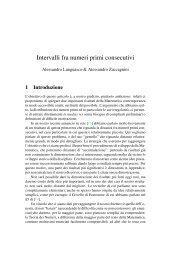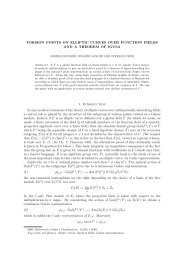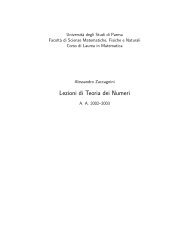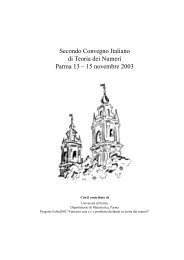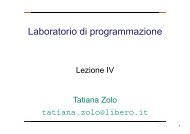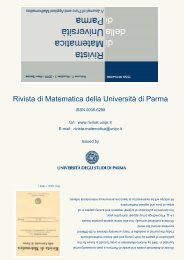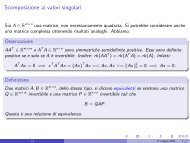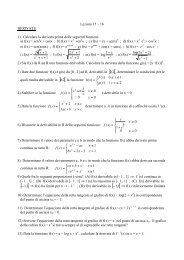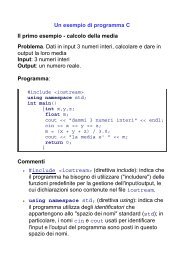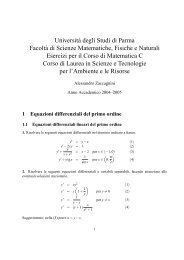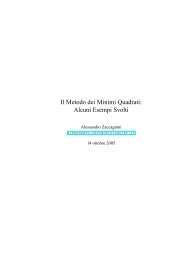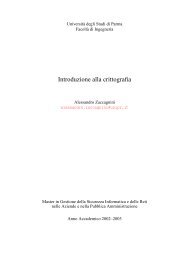ASPECTS OF IWASAWA THEORY OVER FUNCTION FIELDS 1 ...
ASPECTS OF IWASAWA THEORY OVER FUNCTION FIELDS 1 ...
ASPECTS OF IWASAWA THEORY OVER FUNCTION FIELDS 1 ...
You also want an ePaper? Increase the reach of your titles
YUMPU automatically turns print PDFs into web optimized ePapers that Google loves.
<strong>IWASAWA</strong> <strong>THEORY</strong> <strong>OVER</strong> <strong>FUNCTION</strong> <strong>FIELDS</strong> 13µ A on P 1 (F ∞ ); this fact can be exploited to construct elements (our p-adic L-functions) inIwasawa algebras in the following way.Let K be a quadratic algebra over F : an embedding of K into the F -algebra of 2 × 2matrices M 2 (F ) gives rise to an action of the group G := (K ⊗ F ∞ ) ∗ /F ∗ ∞ on the P GL 2 (F ∞ )-homogeneous space P 1 (F ∞ ). Class field theory permits to relate G to a subgroup Γ of ˜Γ =Gal(F/F ), where F is a certain extension of F (depending on K) ramified only above ∞.Then the pull-back of µ A to G yields a measure on Γ; this is enough because Meas(Γ, R) iscanonically identified with R ⊗ Λ (and Meas 0 (Γ, R) with the augmentation ideal). Variousinstances of the construction just sketched are explained in [30] for the case when A is anelliptic curve: here one can take R = Z. Similar ideas were used in Pál’s thesis [37], wherethere is also an interpolation formula relating the element in Z[[Γ]] so obtained to special valuesof the complex L-function. One should also mention [38] for another construction of p-adicL-function, providing an interpolation property for one of the cases studied in [30]. Noticethat in all this cases the p-adic L-function is, more or less tautologically, in the augmentationideal.A different approach had been previously suggested by Tan [43]: starting with cuspidalautomorphic forms, he defines elements in certain group algebras and proves an interpolationformula [43, Proposition 2]. Furthermore, if the cusp form is “well-behaved” his modularelements form a projective system and originate an element in an Iwasawa algebra of thekind considered in the present paper: in particular, this holds for non-isotrivial elliptic curveshaving split multiplicative reduction. In the case of an elliptic curve over F q (T ) Teitelbaum[46] re-expressed Tan’s work in terms of modular symbols (along the lines of [31]); in [21] itis shown how this last method can be related to the “quadratic algebra” techniques sketchedabove.A unified treatment of all of this will appear in [4].Thus for a modular abelian variety A/F we can define both a Fitting ideal and a p-adicL-function: it is natural to expect that an Iwasawa Main Conjecture should hold, i.e., thatthe Fitting ideal should be generated by the p-adic L-function.Remark 4.1. In the cases considered in this paper (involving a modular abelian varietyand a geometric extension of the function field) the Iwasawa Main Conjecture is still wideopen. However, recently there has been some interesting progress in two related settings:both results are going to appear in [29].First, one can take A to be an isotrivial abelian variety (notice that [43, page 308] definesmodular elements also for an isotrivial elliptic curve). Ki-Seng Tan has observed that thenthe Main Conjecture can be reduced to the one for class groups, which is already known tohold (as it will be explained in the next section).Second, one can take as F the maximal arithmetic pro-p-extension of F , i.e., F = F arit =F F (p)F, where F(p)Fis the subfield of F F defined by Gal(F (p)F/F F ) ≃ Z p (notice that this is thesetting of [35, Theorem 1.7]). In this case Trihan has obtained a proof of the Iwasawa MainConjecture, by techniques of syntomic cohomology. He needs no assumption on the abelianvariety A/F : his p-adic L-function is defined by means of cohomology and it interpolates theHasse-Weil L-function.5. Class groupsFor any finite extension L/F , A(L) will denote the p-part of the group of degree zero divisorclasses of L; for any F ′ intermediate between F and F, we put A(F ′ ) := lim←A(L) as L runsamong finite subextensions of F ′ /F (the limit being taken with respect to norm maps). Thestudy of similar objects and their relations with zeta functions is an old subject and was the



